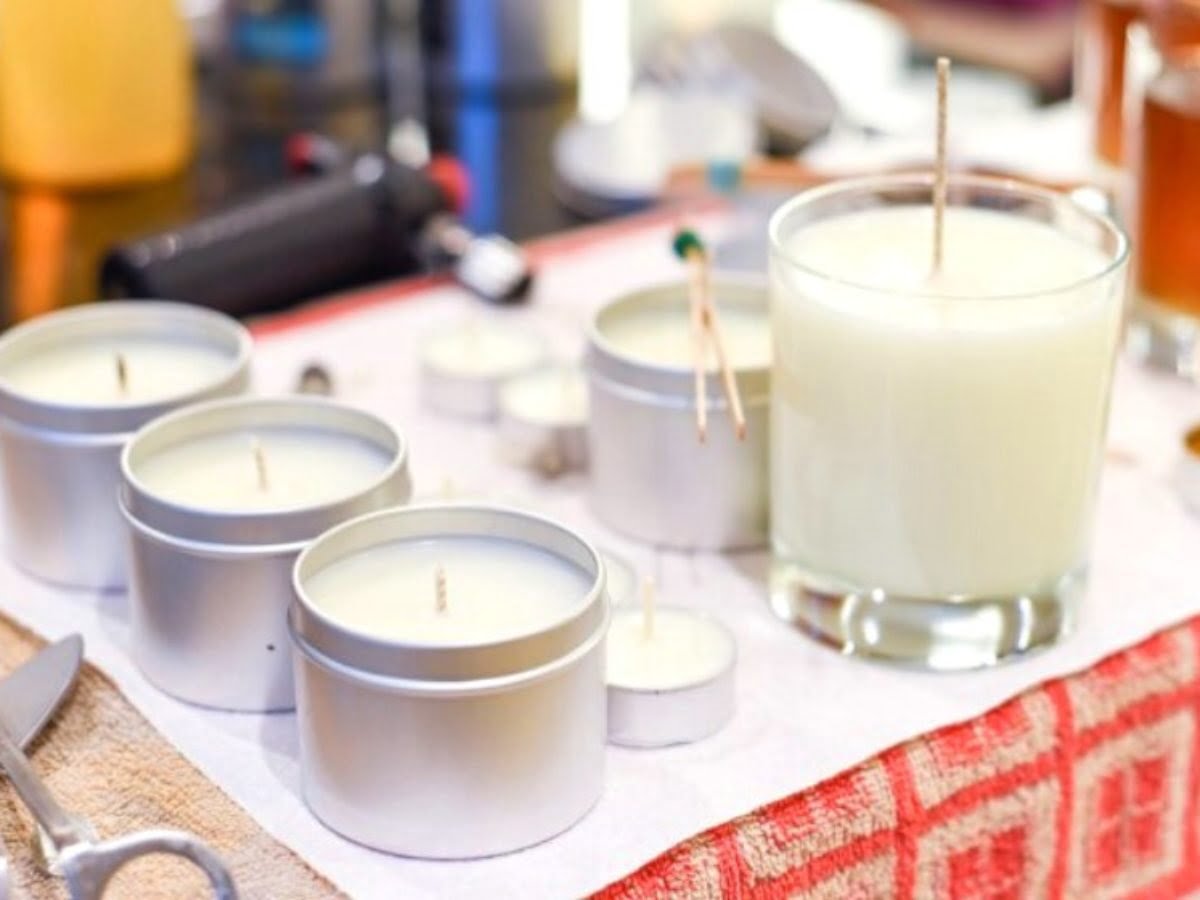The growing trend of homemade candle making has ignited a desire for individuals to create personalized, aromatic spaces within their homes. However, amidst the excitement and creativity that comes with this craft, one crucial element often gets overlooked-the choice of oil. Addressing the common dilemma “What kind of oil should I use for candle making?”, this article delves into the significance of selecting the right oil to ensure a successful and enjoyable candle making journey.
When it comes to candle making, oil plays an integral role in both fragrance and performance. The type of oil used can greatly impact the overall scent throw, burn time, and even safety aspects of the candles. With a wide array of options available, understanding which oils work best in different situations becomes essential.
In this informative guide, we will explore various types of oils suitable for candle making and how they interact with different types of candle waxes. Whether you prefer the aromatic qualities of essential oils or enjoy the long-lasting scents provided by fragrance oils, we will cover it all. Additionally, we will discuss the advantages of using natural oils for those looking for sustainable and eco-friendly alternatives.
By providing insights into heat resistance, flash points, proper ratios, mixing techniques, troubleshooting common issues, and more, this article aims to equip budding candle makers with the knowledge needed to make informed choices regarding their oil selection. So let’s dive in and discover the perfect oil that will enhance your candle-making experience while creating beautifully scented spaces that reflect your own unique style.
Understanding the Different Types of Candle Waxes
When it comes to candle making, understanding the different types of candle waxes is essential in determining the right oil to use. Each type of wax has its own unique properties and characteristics that can impact the choice of oil. Here is an introduction to the various types of candle waxes and factors to consider when selecting oil based on the wax type.
- Paraffin Wax: Paraffin wax is a popular choice for candle making due to its affordability and versatility. It is derived from petroleum and offers excellent scent throw and burn time. When working with paraffin wax, it is important to choose oils that are compatible with petroleum-based products, such as fragrance oils or mineral oils.
- Soy Wax: Soy wax has gained popularity in recent years due to its natural origin and eco-friendly properties. It is made from soybean oil and produces clean-burning candles with a longer burning time. With soy wax, it is recommended to use natural oils or essential oils that can complement its clean and subtle scent profile.
- Beeswax: Beeswax is another natural option for candle making that provides a warm and pleasant aroma when burned. As beeswax has a high melting point, it requires oils with good heat resistance. Natural oils like coconut oil or palm oil can be suitable choices for enhancing the performance of beeswax candles.
- Palm Wax: Palm wax, derived from palm oil, is known for its unique crystalline appearance that gives candles an attractive texture. Palm wax melts at higher temperatures, so using oils with a higher flash point is recommended for optimal results.
- Gel Wax: Gel wax offers a different experience compared to traditional waxes as it creates transparent candles with the ability to suspend decorative objects within them. When working with gel wax, fragrance oils specifically designed for gel candles should be used to ensure proper scent release and performance.
Aside from these commonly used waxes, there are also blends available in the market that combine different waxes to achieve desired properties. Each type of wax requires careful consideration when selecting oils to ensure compatibility and maximize the candle’s performance.
Essential Oils
Exploring the World of Essential Oils
Essential oils have gained immense popularity in recent years, not only for their aromatic properties but also for their numerous therapeutic benefits. Derived from various plants, essential oils are highly concentrated extracts that capture the natural scent and essence of the plant. Each essential oil boasts unique characteristics and properties, making them a versatile choice for candle making.
When choosing essential oils for your candles, it is important to consider factors such as scent intensity, compatibility with other oils and waxes, and the desired mood or ambiance you wish to create. Some popular essential oils commonly used in candle making include lavender, lemon, peppermint, eucalyptus, and rosemary.
Creating Ambiance and Mood
One of the main advantages of using essential oils in candle making is their ability to create a specific ambiance or mood in a space. For example, lavender oil is known for its calming effects and can promote relaxation, making it an excellent choice for bedroom or meditation candles. On the other hand, citrus-based oils like lemon or orange can uplift moods and create a vibrant atmosphere.
Moreover, essential oils can also help to enhance focus and concentration. Scents like rosemary or peppermint are often utilized in study areas or workspaces to stimulate mental clarity. By carefully selecting different essential oils based on their properties, you can effectively transform any space into a calming sanctuary or an energizing environment.
Recommendations for Complementary Candle Scents
To further enhance your candle-making experience with essential oils, it is helpful to know which scents complement each other well. Combining harmonious scents not only creates an appealing aroma but can also add complexity and depth to your candles’ fragrance profile.
For instance, floral scents like rose or jasmine pair beautifully with refreshing citrus fragrances such as bergamot or grapefruit. On the other hand, if you prefer earthy or woody scents, combining cedarwood with patchouli or sandalwood can create a warm and grounding aroma. Experimenting with complementary essential oil combinations is a fun and creative way to add your personal touch to your candles.
Fragrance Oils
Fragrance oils play a crucial role in enhancing the scent and performance of candles. They are specifically formulated to provide stronger and longer-lasting fragrances compared to essential oils. When choosing fragrance oils for candle making, there are several factors to consider.
Firstly, it is important to ensure that the fragrance oil is compatible with the type of wax being used. Different waxes have different properties and can react differently with certain fragrance oils. For example, soy wax tends to have better scent throw with certain types of fragrance oils, while paraffin wax may work well with a wider range of fragrances. It is recommended to do a small test batch before committing to a large production to ensure compatibility.
Another factor to consider when choosing fragrance oils is the concentration or percentage of oil needed for optimal scent throw. Some fragrance oils may require a higher percentage to achieve the desired strength while others may be more potent at lower concentrations. It is important to follow the manufacturer’s guidelines and recommendations for each specific fragrance oil.
When it comes to selecting specific fragrance oils, there are numerous options available with unique characteristics and scents. Popular choices include floral scents like jasmine or rose, fruity scents like apple or citrus, and even more unique options like herbal or woodsy scents. It is recommended to choose fragrance oils that complement the intended ambiance or mood you want to create with your candles.
To summarize, fragrance oils are an excellent choice for enhancing the scent and performance of candles. When selecting them, it is important to consider compatibility with the wax being used, the required concentration for optimal scent throw, and choose fragrances that align with your desired ambiance or mood. By carefully selecting fragrance oils, you can create candles that delight both visually and aromatically.
Natural Oils
In recent years, there has been a growing emphasis on sustainability and eco-friendly options in various industries, including candle making. Many candle makers are now turning to natural oils as a more sustainable and environmentally friendly choice for their creations. Natural oils offer several advantages over synthetic or petroleum-based oils, making them an excellent option for those concerned about the impact of their candle making practices on the planet.
One of the significant advantages of using natural oils in candle making is their renewable nature. Unlike synthetic or petroleum-based oils, which require fossil fuel extraction processes that contribute to environmental harm, natural oils are derived from plant sources that can be replanted and replenished indefinitely. This makes natural oils an attractive choice for eco-conscious individuals who want to reduce their carbon footprint.
Furthermore, natural oils offer unique aromas and qualities that cannot be replicated by synthetic fragrance oils. By using natural oils such as lavender, citrus, or eucalyptus, candle makers can create scents that have a therapeutic effect on the ambiance and mood of a space. These essential oils not only provide beautiful fragrances but also offer potential health benefits such as relaxation, stress relief, and improved air quality when used in candles.
When selecting natural oils for your candles, it is crucial to ensure their quality and authenticity. Look for reputable suppliers that provide organic or sustainably sourced options. Additionally, consider conducting tests to evaluate how different natural oils perform in terms of scent throw and burn performance before incorporating them into your candle-making process.
By choosing natural oils for your candle making journey, you not only contribute to environmental preservation but also create a unique olfactory experience for yourself and others. Experiment with different combinations of natural essential or fragrance oil blends to find scents that resonate with you while maintaining a sustainable approach to your craft.
Safety Considerations
In the process of choosing the right oil for candle making, it is important to consider safety considerations such as heat resistance and flash points. These factors play a crucial role in the performance and safety of your candles. Understanding how different oils handle heat can help you make informed decisions and avoid potential hazards.
Heat resistance refers to an oil’s ability to withstand high temperatures without breaking down or releasing harmful substances. It is imperative to select oils with high heat resistance for candle making, as they will need to withstand the heat of the flame without producing any negative effects. Oils with low heat resistance may result in excessive smoke, soot production, or even combustion, posing risks to both your safety and the environment.
Another important consideration is the flash point of the oil, which determines the temperature at which it can ignite when exposed to an open flame or spark. Oils with lower flash points have a higher risk of catching fire during candle burning. To ensure safety, it is recommended to choose oils with flash points above the typical operating temperature of a candle flame (around 700°F or 370°C). This reduces the likelihood of accidents or fire hazards.
| Oil | Flash Point (°F) |
|---|---|
| Coconut Oil | 360°F (182°C) |
| Soybean Oil | 440°F (227°C) |
| Palm Oil | 446°F (230°C) |
It is essential to check specific guidelines and safety data sheets provided by the manufacturer of the oil you intend to use, as flash points can vary depending on the purity and other factors. Additionally, be sure to monitor your candle while it is burning and follow basic candle safety practices to prevent accidents.
By considering the heat resistance and flash points of oils, you can ensure a safer candle making experience while maintaining optimal performance and quality in your homemade candles.
Tips for Proper Oil-to-Wax Ratios and Mixing Techniques
When it comes to candle making, getting the oil-to-wax ratio just right is essential for achieving optimal scent throw and candle performance. The amount of oil you use in relation to the amount of wax will directly affect the strength of the fragrance in your candles. Additionally, mastering the art of mixing techniques can ensure that your oils are evenly distributed throughout the wax, resulting in a consistent and well-performing candle.
Guidelines for determining the appropriate oil-to-wax ratios:
Finding the perfect oil-to-wax ratio requires careful consideration and experimentation. While there are no hard and fast rules, here are some guidelines to help you get started:
- For soy wax: A commonly recommended ratio is 1 ounce of oil for every pound of soy wax. However, if using highly concentrated fragrance oils or essential oils, you may need to reduce this ratio slightly to prevent an overpowering scent.
- For paraffin wax: The general rule of thumb is 1 ounce of oil per pound of wax. Keep in mind that paraffin can typically hold more fragrance than soy wax, so be cautious not to add too much.
- For beeswax: Beeswax has a natural honey-like aroma and is less receptive to fragrance than other waxes. Typically, a lower oil-to-wax ratio of around 0.5 ounces per pound is sufficient.
Different methods for integrating oils into candles:
There are various techniques you can use to mix oils with your chosen wax:
- Hot technique: This method involves adding your fragrance oil or essential oil when the melted wax reaches a specific temperature (usually between 175-185°F). Stir continuously for several minutes to ensure proper distribution.
- Cold technique: With this method, you add the fragrance oil or essential oil after the wax has cooled and solidified slightly. Simply melt the wax, allow it to cool to around 125-135°F, and then stir in the desired amount of oil.
Regardless of the method you choose, it is crucial to mix the oil and wax thoroughly to prevent any separation or uneven distribution. Avoid excessive stirring that may introduce air bubbles into the mixture, as these can affect the overall quality and appearance of your finished candles.
| Oil Type | Recommended Oil-to-Wax Ratio |
|---|---|
| Soy Wax | 1 ounce of oil per pound of soy wax (adjust for concentrated oils) |
| Paraffin Wax | 1 ounce of oil per pound of paraffin wax |
| Beeswax | 0.5 ounces of oil per pound of beeswax |
Mastering the proper oil-to-wax ratio and mixing techniques takes practice, so don’t be afraid to experiment with different amounts and methods until you achieve your desired results. Remember to keep track of your measurements and observations during testing, as this will help you refine your candle-making process over time. By paying attention to these details, you can create candles that not only look beautiful but also fill a space with captivating aromas.
Troubleshooting Common Issues with Oil Selection
Addressing Common Problems
One of the most common issues that can arise from using unsuitable oils in candle making is a poor scent throw. Scent throw refers to how well a candle disperses its fragrance when it is burned.
If you find that your candles are not emitting enough fragrance, it may be due to using an oil that does not have a strong enough scent or one that does not blend well with the other ingredients in the candle. To resolve this issue, try experimenting with different oils or adjusting the oil-to-wax ratio to achieve a stronger scent throw.
Another problem that may occur is excessive soot production. Soot is the black residue that can accumulate on the inside of containers and on surfaces near burning candles. Certain oils, particularly those with high levels of impurities, can contribute to increased soot production. If you notice excessive soot, consider switching to oils with lower levels of impurities or choosing cleaner-burning options like soy wax or beeswax.
Troubleshooting Guide
To avoid costly mistakes when selecting oils for candle making, it’s important to be able to identify and resolve any issues that may arise. Here are some troubleshooting tips:
- Poor scent throw: Experiment with different oils or adjust the oil-to-wax ratio to achieve a stronger fragrance.
- Excessive soot production: Switch to oils with lower levels of impurities or choose cleaner-burning waxes like soy or beeswax.
- Uneven burning: Make sure the chosen oil has a suitable flash point and heat resistance.
- Candle tunneling: Adjust the oil-to-wax ratio and ensure proper wick trimming to prevent uneven burning.
Remember that candle making is a process of trial and error, so don’t get discouraged if you encounter issues along the way. Keep track of your experiments and make note of which combinations work best for your candles.
Conclusion
In conclusion, choosing the right oil is crucial for a successful candle making journey. Throughout this article, we have explored the importance of selecting oils that complement the type of wax used in candles, whether it be paraffin, soy, or beeswax.
We have also delved into the aromatic and therapeutic benefits of essential oils and the ability of fragrance oils to enhance scent and performance. Furthermore, we have discussed the advantages of using natural oils for candle making, highlighting their sustainability and eco-friendliness.
Safety considerations such as heat resistance and flash points were also addressed in this article, emphasizing the need to select oils that can withstand high temperatures without compromising candle performance. Additionally, we provided tips for determining appropriate oil-to-wax ratios and mixing techniques to achieve optimal scent throw and overall candle quality.
Lastly, it is important to troubleshoot any issues that may arise from using unsuitable oils. By identifying and resolving problems such as poor scent throw or soot production, candle makers can avoid costly mistakes in their oil selection process.
Frequently Asked Questions
What kind of oil is best for candle making?
When it comes to candle making, the kind of oil that works best will depend on the specific type of candle you are making and the desired fragrance. Generally, fragrance oils or essential oils are commonly used in candle making to add scent to the candles. Fragrance oils are synthetic substances that come in a wide range of scents, while essential oils are derived from natural sources such as plants or flowers.
Both can be used to create aromatic and beautiful candles. However, it is important to note that not all oils are suitable for candle making, as some may have a low flash point or produce too much soot when burned.
Can you use any oil to make candles?
While it is possible to experiment with using various types of oil in candle making, not all oils are suitable or recommended for this purpose. For instance, cooking oils like vegetable oil or olive oil are not typically used because they tend to have a low flash point and may create excessive smoke when burned.
It is important to use oils that have been specifically formulated for candle making to ensure safe burning and optimal results. Using unsuitable oils might result in poor scent throw, uneven burning, or even safety hazards.
Do you need special oils for candle making?
Special oils designed specifically for candle making are indeed recommended for achieving the best results in terms of both scent performance and safety during burning. These special oils often referred to as fragrance oils or essential oils, have been created with specific formulations that make them suitable for being melted in the wax and released into the air when the candle burns.
They offer a wide array of scents and varying strengths to cater to individual preferences and requirements for different types of candles like container candles, pillars, or votives. It is always advisable to carefully select high-quality fragrance or essential oils which have been tested and deemed appropriate for candle making purposes by reliable suppliers or manufacturers within the industry.

Welcome to my candle making blog! In this blog, I will be sharing my tips and tricks for making candles. I will also be sharing some of my favorite recipes.





